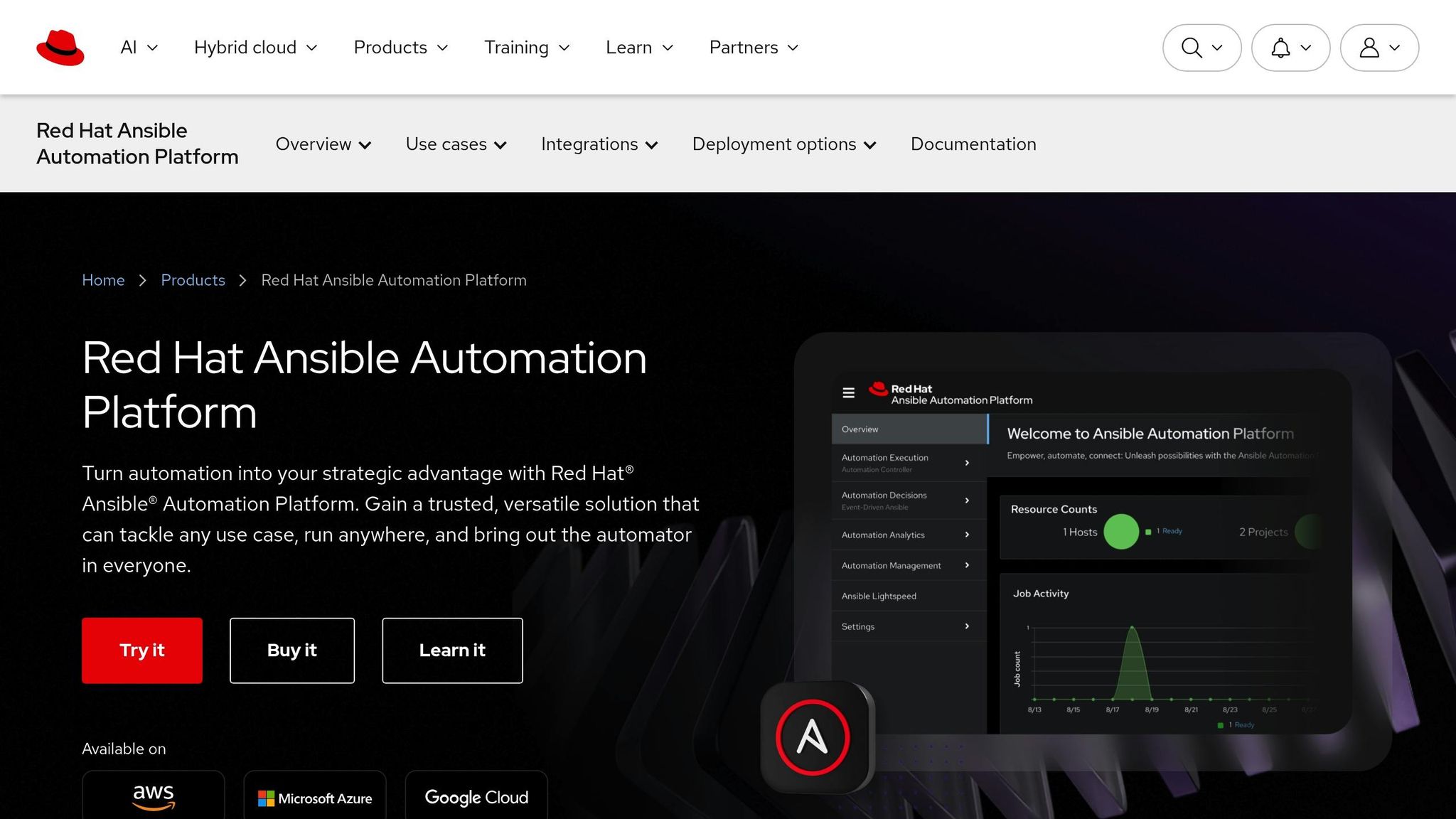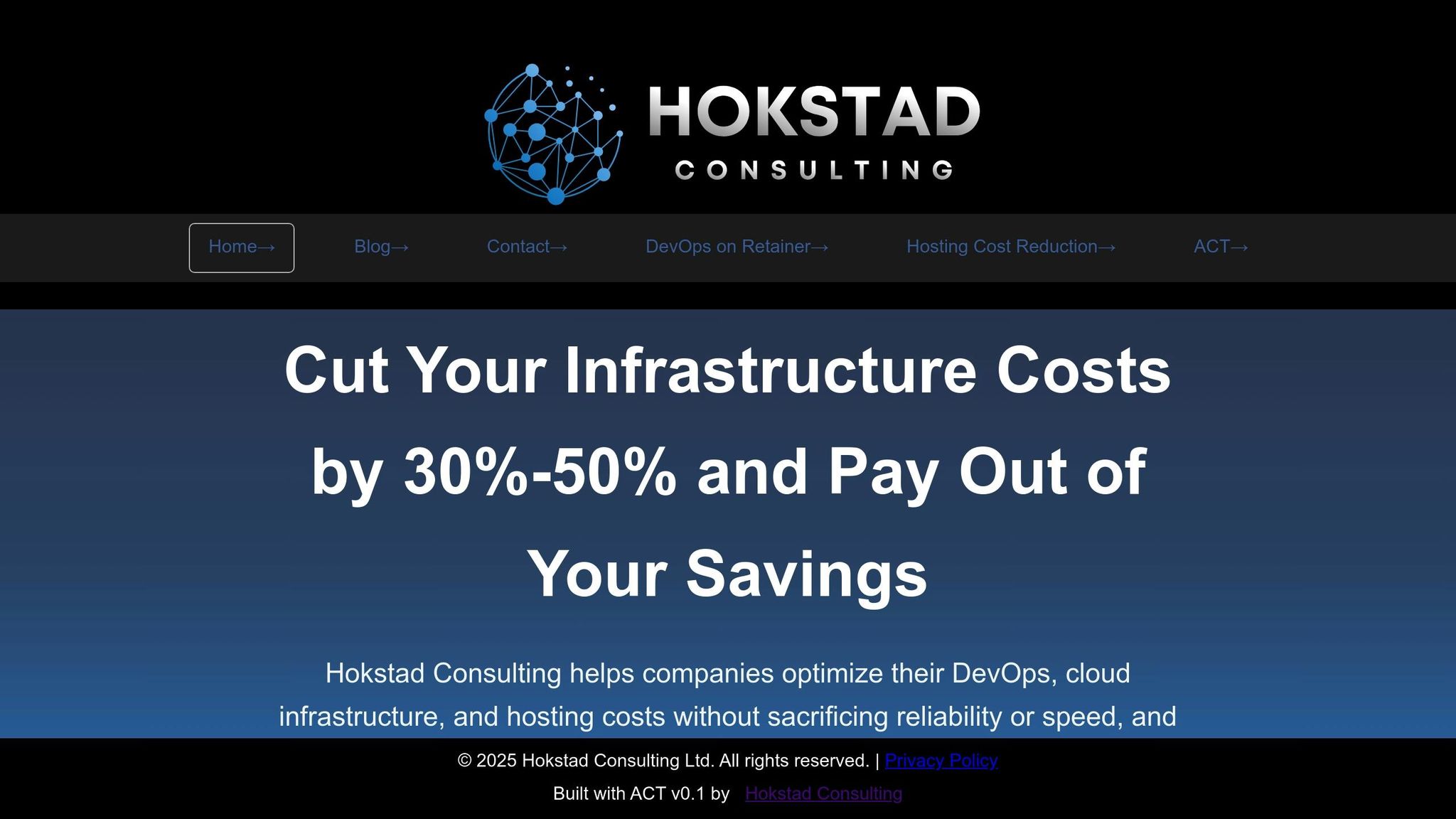Choosing between Ansible and Terraform boils down to understanding their approaches and aligning them with your infrastructure needs. Terraform uses a declarative model, where you specify the desired end state of your infrastructure, and it handles the steps to get there. Ansible, on the other hand, follows a procedural approach, requiring you to define each step in sequence to achieve the desired outcome.
Key Points:
- Terraform: Ideal for provisioning and managing cloud infrastructure. It tracks resource states, ensures consistency, and automates dependencies.
- Ansible: Best for configuration management and detailed orchestration tasks, particularly in hybrid or legacy environments.
Quick Comparison:
| Aspect | Terraform (Declarative) | Ansible (Procedural) |
|---|---|---|
| Approach | Define the desired state | Define step-by-step tasks |
| Primary Use Cases | Cloud provisioning | Configuration management |
| State Management | Maintains a state file | No centralised state tracking |
| Learning Curve | Steeper (requires HCL & infra concepts) | Easier (YAML-based syntax) |
| Dependency Handling | Automated | Manual |
For UK businesses, Terraform simplifies cloud migrations and compliance tracking, while Ansible excels in managing hybrid setups and complex workflows. Many teams combine both tools to leverage their strengths effectively.
Ansible vs. Terraform: What's the difference?

Declarative IaC with Terraform
Terraform is a prime example of how declarative Infrastructure as Code (IaC) works. Instead of scripting a series of steps, Terraform allows you to define the end state of your infrastructure. It then takes care of figuring out how to get there.
How Declarative IaC Works
In a declarative model, you focus on describing the desired outcome rather than spelling out every action needed to achieve it. With Terraform, you define what your infrastructure should look like, and it determines the necessary steps to align the current setup with your specified configuration.
Terraform uses HashiCorp Configuration Language (HCL), which makes configurations straightforward and easy to read. It ensures idempotency by comparing the desired state with the actual state of your infrastructure. A state file serves as the single source of truth, keeping track of all managed resources. This allows Terraform to decide what needs to be created, updated, or removed, streamlining the entire process.
Terraform's Key Features
Terraform’s declarative approach comes with several standout features:
-
Commands for Workflow: The workflow is simple yet effective:
-
terraform init: Sets up providers. -
terraform plan: Previews the changes required. -
terraform apply: Executes the changes in the correct dependency order.
-
Resource Graph: Terraform builds a resource graph that maps relationships between infrastructure components. This ensures resources are provisioned in the right sequence and that dependencies are respected.
Provider Ecosystem: Its extensive library of providers allows you to manage resources across multiple cloud platforms and specialised services, giving you unmatched flexibility.
Terraform’s approach combines simplicity and power, making it a go-to tool for managing infrastructure declaratively.
Procedural IaC with Ansible
Ansible takes a procedural approach to Infrastructure as Code (IaC), focusing on executing well-defined tasks in a specific sequence. Instead of simply defining the desired end state, you outline the exact steps required to configure and manage your infrastructure.
How Procedural IaC Works
The procedural model is all about controlling each step of the provisioning process. With Ansible, you write detailed instructions that are executed in order, giving you full control over how tasks are performed.
Ansible relies on YAML-based playbooks to organise these instructions. Each task within a playbook performs a specific action, such as installing software, copying files, or restarting services. These tasks are executed one after another, making it easier to handle workflows that depend on precise timing or coordination.
This approach is particularly useful for legacy systems or complex migrations where the journey to the desired configuration is just as critical as the end result. The sequential execution aligns perfectly with Ansible's extensive feature set, making it a strong choice for such scenarios.
Ansible's Key Features
Ansible's procedural model is supported by several standout features:
Agentless Architecture: Ansible connects to systems using SSH or WinRM, eliminating the need to install additional software on target nodes. This reduces security risks and simplifies deployment across diverse setups.
Playbook Structure and Modules: YAML playbooks organise tasks into a clear sequence. With over 3,000 modules (many of which are idempotent), Ansible ensures efficient system configuration. Each playbook targets specific hosts and executes tasks in the defined order.
Inventory Management: Ansible supports both static and dynamic inventories, allowing you to group systems and apply configurations tailored to environments like development, staging, or production. The same playbooks can be reused with different variable sets for flexibility.
Ansible Strengths and Weaknesses
Ansible's structured execution brings both advantages and challenges.
One of its key strengths is simplicity. Writing YAML playbooks is straightforward, making Ansible accessible even to system administrators without extensive programming experience. Teams can easily automate tasks that mirror their existing manual processes, easing the transition to DevOps practices.
Another advantage is its flexibility. Ansible shines when dealing with unique workflows or edge cases that aren't easily managed by declarative tools. For example, it’s highly effective for database migrations, rolling updates across application tiers, or integrating with proprietary systems. The ability to control each step is invaluable in these scenarios.
However, this flexibility comes with some drawbacks. Dependency management requires careful planning to ensure tasks execute in the correct order. Unlike declarative tools that handle resource dependencies automatically, Ansible relies on you to define the sequence.
State management is another challenge. Ansible doesn’t maintain a detailed state file, which can make it harder to track changes or identify configuration drift over time. Teams often need to supplement Ansible with monitoring tools to maintain consistency.
Lastly, as automation needs grow, playbook complexity can become a concern. What starts as simple scripts can evolve into intricate workflows that are harder to manage and debug.
For organisations in the UK, Ansible is particularly well-suited for tasks like configuration management, application deployment, and orchestration. It excels in hybrid environments where coordinating operations between cloud and on-premises systems is essential, especially when the order of operations plays a critical role.
Ansible vs Terraform Comparison
Here’s a closer look at how Ansible and Terraform stack up against each other. This breakdown helps determine which tool aligns best with your organisation's needs.
Comparison Table: Ansible vs Terraform
| Aspect | Ansible (Procedural) | Terraform (Declarative) |
|---|---|---|
| Approach | Executes tasks step by step in a defined sequence | Defines the desired state and manages resources automatically |
| State Management | No centralised state file; relies on system checks | Maintains a detailed state file tracking all resources |
| Primary Use Cases | Configuration management, application deployment, orchestration | Infrastructure provisioning and cloud resource management |
| Learning Curve | Easier for system administrators familiar with YAML | Steeper; requires learning HCL and infrastructure concepts |
| Dependency Handling | Manual ordering; tasks must follow an explicit sequence | Automatically resolves dependencies based on resource relationships |
| Modularity | Uses roles and collections for reusable components | Relies on modules and providers for infrastructure abstraction |
| Cloud Integration | Offers extensive module support | Provides native integration with cloud providers and their APIs |
| Rollback Capabilities | Limited; custom rollback procedures needed | Includes plan previews and selective resource destruction |
| Idempotency | Varies by module; not guaranteed across all operations | Ensured through state comparison and drift detection |
This table highlights the main differences to guide your decision-making process.
Choosing the Right Tool for UK Organisations
Deciding between Ansible and Terraform largely depends on your organisation's specific needs and existing infrastructure. Many UK businesses operate in hybrid environments, where these tools often complement each other.
Terraform shines when it comes to building and managing cloud infrastructure. For organisations migrating to platforms like AWS, Azure, or Google Cloud, its declarative nature ensures consistent environments. The state management feature is particularly helpful for maintaining audit trails, which is vital for compliance.
For cost-conscious teams, Terraform’s plan preview is a valuable feature. It provides a clear picture of resource changes before they’re applied, helping to avoid unnecessary expenses.
Ansible, on the other hand, is ideal for scenarios requiring precise control over deployments or when working with legacy systems. UK organisations managing on-premises infrastructure during cloud migrations often benefit from Ansible’s ability to orchestrate complex workflows. For instance, it can handle tasks like database migrations, software updates, and service restarts in a specific order.
Many teams in the UK combine the strengths of both tools - using Terraform for provisioning infrastructure and Ansible for configuration management.
Your team’s expertise also plays a role in choosing the right tool. System administrators often gravitate towards Ansible due to its YAML syntax, while development-oriented teams may find Terraform’s approach more intuitive.
For UK organisations, compliance remains a critical consideration, especially in sectors like healthcare or financial services. Terraform’s state files provide comprehensive audit trails, while Ansible’s task-based logs offer detailed visibility into configuration changes. Both tools can meet compliance requirements, but they do so in different ways, depending on your operational priorities.
Need help optimizing your cloud costs?
Get expert advice on how to reduce your cloud expenses without sacrificing performance.
Recommendations for UK DevOps Teams
Choosing between declarative and procedural Infrastructure as Code (IaC) approaches isn’t a one-size-fits-all decision. It requires a thorough evaluation of your organisation’s goals, team expertise, and long-term plans.
Best Practices for Tool Selection
When selecting tools, UK DevOps teams should keep these key considerations in mind:
Start by evaluating your current infrastructure. Many UK organisations juggle legacy systems alongside modern cloud environments. If your primary goal is provisioning new cloud resources, Terraform’s declarative style can simplify the process. On the other hand, if you’re managing existing systems or need precise control over deployment steps, Ansible’s procedural approach might be more effective.
Understand your team’s core skills. The success of any tool hinges on your team’s ability to use it effectively.
Address compliance requirements early. For sectors like financial services or healthcare, where compliance is critical, Terraform offers strong audit trail capabilities, while Ansible provides detailed logs for granular tracking.
Look beyond licensing costs. Terraform’s plan preview feature helps avoid costly errors by showing proposed changes before implementation - an asset for UK businesses working within tight cloud budgets. Meanwhile, Ansible’s agentless design reduces infrastructure overhead, offering cost savings for large-scale deployments.
Plan for scalability from the start. Terraform shines when managing large cloud infrastructures, thanks to its dependency handling and state management. Ansible, while excellent for managing configurations across multiple servers, requires more careful orchestration for complex setups.
Using Both Approaches Together
Many UK DevOps teams find that combining Terraform and Ansible delivers the best results. This hybrid strategy leverages the strengths of both tools while minimising their limitations.
- Use Terraform for provisioning infrastructure and Ansible for configuration management. For example, Terraform can create virtual machines, networks, and storage, while Ansible handles software setup and application deployment.
- Define clear roles for each tool. Terraform should manage infrastructure lifecycle tasks - creating, updating, and deleting resources - while Ansible focuses on configuration, deployment, and maintenance.
- Ensure seamless workflows by integrating both tools. A common practice is using Terraform to output infrastructure details, like server IPs or database credentials, which Ansible then uses for its tasks.
- Sequence tasks thoughtfully. Typically, Terraform runs first to establish infrastructure, followed by Ansible for configuration. In more complex scenarios, both tools might alternate during iterative deployment processes.
- Keep tool-specific data separate. Terraform should manage its state files, while Ansible maintains its inventory. Mixing these responsibilities often leads to unnecessary complications.
This dual-tool approach provides flexibility and efficiency, particularly for organisations building cloud-based systems.
Hokstad Consulting's IaC Services

For UK organisations navigating the complexities of IaC, Hokstad Consulting offers expert guidance tailored to your needs. Their services are designed to drive practical results and streamline DevOps workflows.
Their cloud cost engineering services focus on reducing expenses. By analysing your infrastructure and deployment patterns, they help clients cut cloud costs by 30-50% through optimised resource provisioning and automated cost management - critical when deciding between declarative and procedural approaches.
With strategic cloud migration services, Hokstad ensures smooth transitions with no downtime. They specialise in hybrid strategies, often combining Terraform and Ansible to maintain service continuity during migrations.
Their custom development and automation solutions go beyond standard implementations. Hokstad develops bespoke Terraform modules, Ansible roles, and integration workflows tailored to your organisation’s unique needs, streamlining deployment cycles and reducing manual effort.
Hokstad’s No Savings, No Fee
model aligns their success with yours, charging fees based on the actual savings they deliver. This approach is especially appealing to budget-conscious UK businesses.
For ongoing support, their retainer model ensures your IaC deployments remain optimised over time. They provide performance tuning, security audits, and infrastructure monitoring to keep Terraform and Ansible running smoothly as your requirements evolve.
Additionally, Hokstad’s expertise in AI-driven DevOps automation makes them a valuable partner for forward-thinking organisations. As AI continues to shape infrastructure management, Hokstad’s ability to integrate traditional IaC tools with emerging AI technologies sets them apart.
Conclusion
UK organisations aiming to modernise their DevOps practices need to understand the key distinctions between declarative and procedural Infrastructure as Code (IaC). Tools like Terraform excel in defining the desired end state, making them ideal for cloud provisioning, while Ansible focuses on step-by-step instructions, offering precise control over both legacy and modern systems.
Rather than committing to just one tool, many successful DevOps teams in the UK combine both approaches. For example, Terraform is often used for infrastructure provisioning, while Ansible handles configuration management. This dual approach allows organisations to play to the strengths of each tool while minimising their shortcomings.
For industries with strict compliance requirements, Terraform's state files provide reliable audit trails, and Ansible's task logs ensure detailed operational visibility. Terraform’s ability to preview plans helps avoid costly mistakes, and Ansible’s agentless design keeps overheads low, which is particularly useful for managing cloud costs.
As infrastructure grows more complex, many organisations find they lack the in-house expertise to navigate these challenges effectively. Specialists like Hokstad Consulting offer tailored solutions for DevOps transformation and cloud cost management. With their No Savings, No Fee
model, they align IaC strategies to meet both technical and business goals seamlessly.
FAQs
How does Terraform's state management help UK organisations with compliance and audit requirements?
Terraform's approach to state management is an essential tool for UK organisations aiming to stay compliant with regulations and audit requirements. By encrypting and securely storing infrastructure data, it aligns with data protection laws, including GDPR, ensuring sensitive information remains safeguarded.
Beyond security, Terraform offers comprehensive records of all infrastructure changes. Features like audit logs and change histories provide a clear view of modifications over time. This level of transparency not only simplifies the process of tracking changes but also helps organisations demonstrate compliance and prepare for audits. These capabilities enable businesses to maintain accurate, verifiable records of their infrastructure with ease.
When should a UK business consider using both Ansible and Terraform together?
UK businesses stand to gain a lot by leveraging Ansible and Terraform together for automating the entire lifecycle of their infrastructure. Terraform shines when it comes to provisioning and managing cloud resources, while Ansible is perfect for configuring and maintaining the software running on those resources.
When used in tandem, these tools can streamline workflows, cut down on manual tasks, and reduce the risk of errors. The result? Consistent environments that are easier to manage. This combination is especially beneficial in fast-paced cloud setups, allowing organisations to fine-tune their operations and respond swiftly to evolving demands.
What challenges might UK DevOps teams encounter when scaling Ansible, and how can they address them?
Challenges and Solutions for Scaling Ansible in UK DevOps Teams
As UK DevOps teams expand their use of Ansible, they often encounter hurdles like managing increasingly complex automation workflows, ensuring uniformity across diverse environments, and upholding strong security measures. These challenges tend to grow as organisations scale and their infrastructure becomes more intricate.
One effective way to tackle these issues is by adopting centralised tools such as Ansible Tower. These tools can simplify automation workflows, enhance visibility into processes, and ensure consistent application of security policies. Alongside this, regular training sessions and maintaining clear, up-to-date documentation can keep team members aligned and skilled, even as systems and demands evolve.
